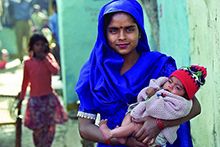
Over the last 15 years, the world has made remarkable progress toward reducing child mortality – from 12 million deaths of children under five in 1990 to just under six million today. However, according to the United Nations, mortality figures remain disproportionately high in South Asia and Sub-Saharan Africa; these two regions accounted for more than 80 percent of global under-five deaths last year.
This challenge is complicated by the fact that, in many low-resource countries throughout these regions, the cause of death is never truly determined due to gaps in health surveillance, registration systems, research and data.
In order to help close these gaps, advance actionable research and save young lives, the Child Health and Mortality Prevention Surveillance (CHAMPS) Network has established three new sites: Kisumu, Kenya; Harar, Ethiopia; and Baliakandi, Bangladesh. These sites – which join existing sites in South Africa, Mali and Mozambique – will work with communities, local organizations and national stakeholders, employing innovative diagnostic, laboratory and surveillance methods to ascertain why young children are dying.

"Our vision for CHAMPS is building knowledge to save children’s lives," says Jeffrey P. Koplan, MD, MPH, vice-president for global health at Emory University, and CHAMPS principal investigator and executive director. "In order to more rapidly reduce child mortality rates, we need a new paradigm in global health partnership and research. CHAMPS is helping focus that effort through surveillance sites that collect and disseminate better data, which helps get the right interventions to children and their families."
At each of its six sites in South Asia and Sub-Saharan Africa, CHAMPS uses a series of scientific processes to collect, analyze and interpret data that help determine causes of death for children under five years old. These findings will be shared with families, communities, healthcare providers, and local and national public health institutes to help inform policies and actions to reduce child mortality. One unique feature of CHAMPS is commitment to rapid, open access to data for clinicians, health practitioners, scientists and researchers around the world.
The CHAMPS Network, led by the Emory Global Health Institute, is composed of more than 15 global organizations, including the U.S. Centers for Disease Control and Prevention (CDC), the International Association of National Public Health Institutes (IANPHI), the Public Health Informatics Institute at the Task Force for Global Health, and Deloitte Consulting LLP. Partner organizations at the newest sites include icddr,b and the Institute of Epidemiology and Disease Control Research in Bangladesh; Haramaya University and the London School of Hygiene and Tropical Medicine in Ethiopia; and the Kenya Medical Research Institute (KEMRI), the CDC and the Henry Jackson Foundation in Kenya.
These organizations join the wider CHAMPS Network, which includes the University of Barcelona; the Center for Vaccine Development in Mali (CVD-Mali) and the University of Maryland, Baltimore (CVD-Baltimore); the University of the Witswatersrand and the National Institute of Communicable Diseases in South Africa; and the Manhiça Health Research Center and the National Institute of Health in Mozambique.
"No child should die of preventable causes. Through collaboration with leading global health organizations, CHAMPS seeks to improve understanding and prevention of child mortality," says Robert F. Breiman, MD, director of the Emory Global Health Institute, and CHAMPS co-principal investigator. "Establishing these sites is a long-term commitment and partnership to building the laboratory, surveillance, training and technology infrastructure to collect data that leads to lifesaving global health actions and outcomes."
Through support from the Bill & Melinda Gates Foundation, CHAMPS is envisioned as a 15- to 20-site network that will take place over a 20-year time frame. In addition to these three new sites in Kenya, Ethiopia and Bangladesh, CHAMPS will establish another site within the next year and additional sites in the future, as well as engage a growing range of stakeholders in the global effort to dramatically reduce child mortality.
